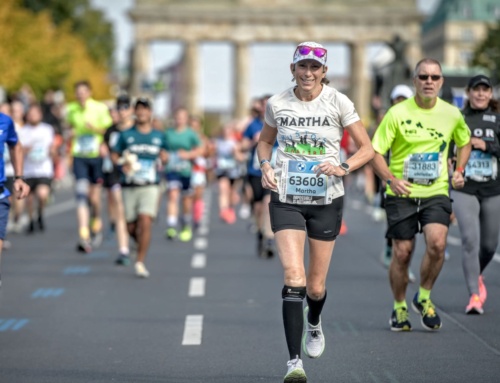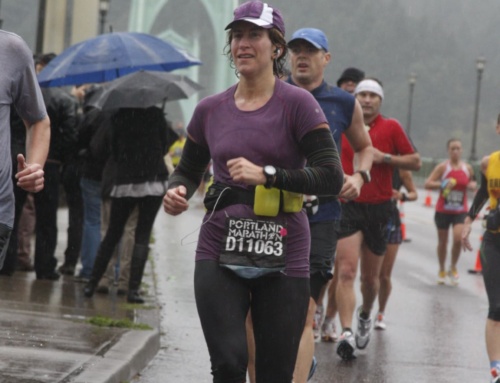
Driving is my Mom Superpower: to swim practice, to camp, to work, to Taylor Swift concert! Photo taken BEFORE the rain and wind.
Thirty minutes. Forty minutes, tops.
This summer, early morning drives to drop my daughter at swim practice followed by a long traffic-choked commute to a desk job have squeezed my run time to shorter and shorter increments. I pack breakfast and lunch the night before, forego makeup, and quit walking the dogs. (Sorry, guys.) Still, it’s Go, go, go!
Once upon a time, 30 minutes meant 3 miles. Or even close to 4 at a tempo pace.
FALL ON THE FLOOR LAUGHING.
No, but really, even with “just” 30 minutes (or 40, if I’m pushing my luck), I do want to make good use of my run time. Maximize efficiency and return on investment, to borrow business jargon. What can I do?
Yes, some days (many days) that means logging whatever I can—2.5 miles (3 on those luck-pushing mornings), generally speaking. (And I recognize that for some mothers, even having 30 minutes to yourself is a rare privilege and treat.)
My best ROI 30-minute workout was inspired by a conversation I had with recently Martin Gibala, a professor of kinesiology at McMaster University in Ontario.

Martin Gibala, professor of kinesiology at McMasters University, is the expert who helped propel the popularity of HIIT.
Gibala is the expert at the forefront high intensity interval training—better known as HIIT, in which you go as hard as you can for bursts of 30 or more seconds, recover and repeat. You have probably done (or at least heard about) HIIT workouts, maybe in Peloton studios or Orange Crush. HIIT is the top fitness trend of 2018, according to the American College of Sports Medicine.
Fun fact sidebar: Way back in 1902, Joe Binks set the world mile record by training one evening per week for 30 minutes. Though he didn’t call HIIT by its trendy acronym, Binks warmed up, ran five or six 110 yards (or the straightaway on a track) at top speed, finishing the workout with a fast 200 to 300 yards. His world record time was 4:16.8. (The current record is 3:43.13.)
Numerous studies have proven the benefits of HIIT for everyone from overweight or obese beginning exercisers to elite athletes. A meta-analysis published in the British Journal of Sports Medicine in 2016 showed that a program of 12 weeks of HIIT improved Vo2 max, waist circumference, blood pressure, and percentage body fat among overweight volunteers.
“For folks just starting out, I can pretty much guarantee that incorporating any type of interval training is going to give them a boost in performance,” Gibala told me. His own studies have proven the effectiveness and promoted the popularity of HIIT, as BAMR Gretchen Reynolds has oft reported in her Phys Ed columns in the New York Times.

Dogs say: “Wait, if you have only 30 minutes, shouldn’t you be walking us instead of RUNNING??”
Of course, most training plans include interval workouts like 800s or half-mile repeats to improve fitness, efficiency, and endurance.
Elite athletes rely on intervals to crank up fitness. Desi Linden, who won this April’s cold and stormy Boston Marathon, famously completes 10 half-mile repeats at faster than marathon pace leading up to goal events. For Linden, that translates to around 2:43 per half mile. (Faint.)
But sustaining longer intervals requires a slower “fast” pace than short HIIT sessions, which call for going all-out (80 to 90 percent of maximum effort for 30-90 seconds). And with just 30 (to 40) minutes, I’d be lucky to get in one mile or maybe two half-mile repeats, if I cheat the cool down. And let’s get real: Even if I had the time, I am never going to do 10 half-mile repeats.
But also, I’m not going to go “all out,” not even for 30 seconds. Because frankly, that sounds hard and possibly even scary.
Can runners benefit from HIIT, even if they don’t go all out? Yes, said Gibala. “People who regularly incorporate some harder sprints into their runs will see their performance improve.”

Best 30 minute score: Dashed into local Jack Rabbit running shop 30 minutes before closing and found sweet sneaks in my size in sale pile. $61! Yes!
Gibala doesn’t run anymore, because knees. (Hmmmm.) He does HIIT on a bike or in the pool, and said if you mix up your running with cross-training, you can do up to 50 percent of your workouts at HIIT.
IMPORTANT NOTE: Because HIIT workouts stress your heart, muscles, joints, and tendons more than a traditional slower workout, it’s best to approach them after you have a baseline of fitness to reduce the risk of injury.
In reality, you reap gains from speed work any way you pick up the pace—whether with old-fashioned half-mile repeats or with searing bursts at 80 to 90 percent of your maximum heart rate.
“Interval training just means alternating periods of higher intensity with periods of lower effort,” Gibala told me. “Varying the pace gives you bigger gains than exercising in a continuous state, even if you’re walking.”

Pro tip: If you are alone on your local track at 6 a.m. (as I do), run some laps in the OPPOSITE direction to decrease injury risk.
My own 30-minute solution is inspired by both Gibala and Joe Binks. I only do it once a week, because I’m still nervous about injury-risk (or I’m just lazy): A 10-minute jog to the high school track, 10 minutes of running the straightaways “fast” (in reality, “less slow”) pretending I am Shalane Flanagan, then 10 minute jog back home.
I’m not going to set any world records, but those hopped-up 30-minute workouts definitely make me feel for the rest of the day like a true BAMR.






I love this idea! I wish I knew if our high school track/stadium is open to the public… I gotta try this out!! Love the new kicks!!
Love your writing Tish – thanks for the ideas.
Love reading about HIIT/intervals for runners. Really wish my local high school (where my daughters attend) track was open to the public. Winter, summer, 6:am… I’d take anything. I’ve asked but it’s gated & locked and they’re just not going to open it. But I can still interval myself around local parks. Thx for the read!